MyPortugalHoliday.com
The best independent guide to Central Portugal
MyPortugalHoliday.com
The best independent guide to Central Portugal
Capela dos Ossos (Chapel of Bones), Evora
The Capela dos Ossos (Chapel of Bones) is one of the most unique religious buildings of Evora, if not the whole of Portugal. This small chapel, which was once part of the Franciscan monastery, is lined with the bones of over 5,000 skeletons that were exhumed from the city's five graveyards during the 16th century.
Contained within the chapel are many thousands of bones, which as well as being respectfully stacked into the recesses are also used to create intriguing, decorative patterns along the arched ceilings and around the columns.
Adding to the macabre atmosphere of the Capela dos Ossos are the death-focused frescos painted on the vaulted ceilings, while on display near the altar is a mummified female and young child. Even the inscription on the entrance to the chapel reads "We, the bones that are here, await yours."
The Capela dos Ossos is truly one of the most fascinating sights of Portugal, but its fame means it may be busy during your visit.
Related articles: Introduction to Evora
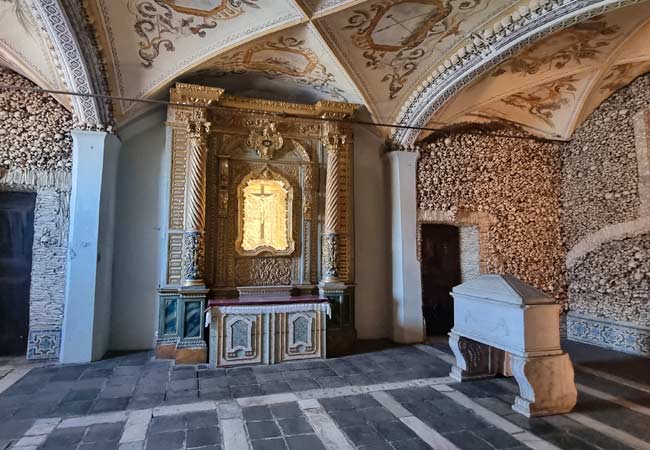
There are thousands of bones and skulls embedded in the walls of the chapel
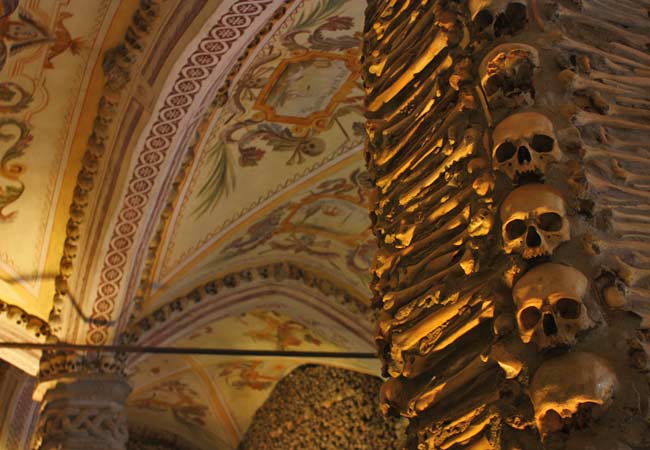
Tourist information for the Capela dos Ossos
The Capela dos Ossos is a highly-recommended tourist attraction of Evora, and is often the most memorable sight of a day trip.
The entrance fee is €6, while there are concession tickets for youths (12 to 25) and seniors (over 65), both costing €4. Children under 12 can enter for free, but parents should really consider if it is suitable for young or impressionable children.
The entrance fee also includes the charming Nativity Collection and the Religious Art Museum, but these are only minor attractions compared to the Bone Chapel.
The Capela dos Ossos is open from 9:00 to 18:30 (summer) or 17:00 (winter). During the peak season, it is best to avoid from 10:30 to 12:00 and 13:00 to 15:00 when the chapel can get overly busy with tours. If possible, it is suggested to visit early or late in the day to experience the true ambience of the chapel, without the hubbub of tourists or the jostling to see the mummies. Also, if you wish to wish to take photos (respectfully, please), it is best to visit early in the day.
The chapel is only small, so a typical visit to the Capela dos Ossos will last around 15 to 20 minutes. A visit can be extended if you choose to view the nativity scene collection, adding 15-20 minutes, and the niche religious art museum if you are interested in the subject.
The Capela dos Ossos is located to the south of the historic centre of Evora (GPS: 38.56872, -7.9086) and lies within the former Franciscan monastery that is attached to the Igreja de São Francisco church. The entrance to the Capela dos Ossos is to the right of the church.
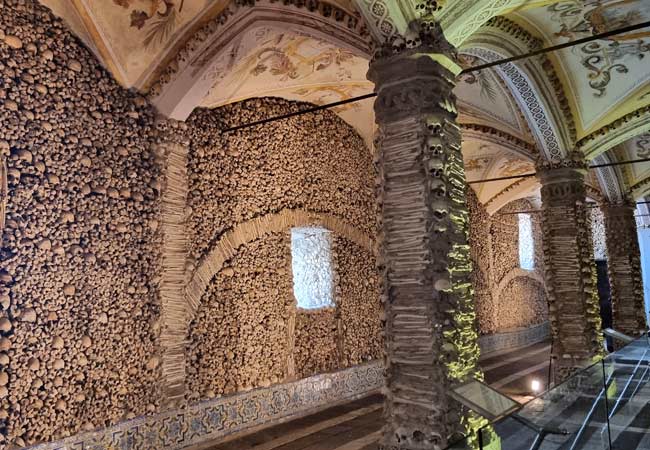
Notable features of the Capela dos Ossos
It is very easy to pass through the chapel quite quickly and miss many of the key features of the chapel.
The stacking of the Bones
The majority of the bones in Capela dos Ossos were meticulously stacked during construction, and very few of the bones are actually held in place by limestone mortar. Considerable care must have been taken to organise and place the bones, and this can be seen by the layer of skulls mid-way up the walls with arches.
To gain an appreciation of the stacking process, a section of bones has been removed near the entrance, which shows the original recesses within the wall.
Insight: Prior to being the Capela dos Ossos, the room was used as a dormitory for the monastery, while the adjoining room (the current ticket office) was the chapter room.
The exhumation and display of the bones in the 16th century was not as morbid as it seems today. This practice aligned with the common beliefs of the era and followed the Counter-Reformation ideology that the bodies would be closer to God.
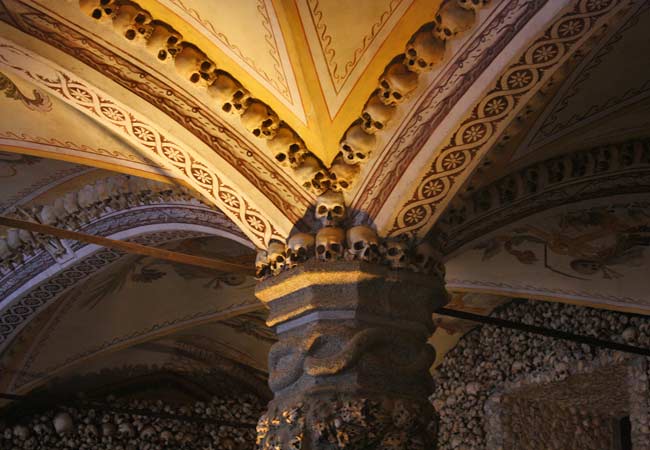
The entrance inscription
On entering the Capela dos Ossos, you will see a marble plinth with the inscription:
“Nos Ossos Que Aqui Estamos Pelos Vossos Esperamos”
"We, the bones that are here, await yours."
As sinister as the inscription reads, it was designed to inspire the deeply religious 17th-century Portuguese. It was meant to emphasise that this life is only a transitory stage to heaven and that following a good Christian life would lead there. Today the words seem much more macabre than the original intended meaning.
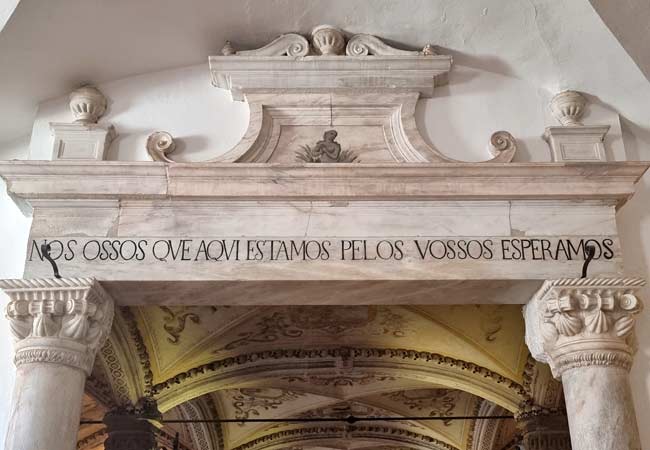
The mummies
During the 16th-century exhumation of the five graveyards, two mummified bodies (an adult and a young child) were unearthed. The adult was originally hung from the right pillar near the altar and was only taken down in 2019 when the two bodies were placed in a glass case.
Insight: The historical legend is that the adult mummy was an unfaithful, drunken man, and the other mummy, his illegitimate son. Both were cursed by his wife at her death, with the words “May the earth of your graves not be destroyed!”. However, 2019 scientific tests revealed the adult mummy is actually a woman, and there are no family links between the two mummies.
Almost anonymity
There are no records or names of the many thousands of skeletons that are found within the walls of the Capela dos Ossos. The only known body is that of Bishop Jacinto Carlos da Silveira, who died in 1808 when Napoleon's French army invaded the city. His tomb lies on the floor in front of the altar.
To the right of the altar is a marble coffin, which contains the bones of the three monks who established the church and monastery in the 13th century.
The frescos
Most visitors see the skull and bone patterns but overlook the fresco paintings and death motifs on the vaulted ceilings. These were painted in 1810 after the construction of the chapel and include death scenes from the bible, skulls and symbols of death.
Insight: Do not miss the fresco featuring a picture of a crib and altar with the inscription "Melior est dies mortis die nativitatis" - "Better is the day of death than the day of birth" - from Ecclesiastes, 7, 1.
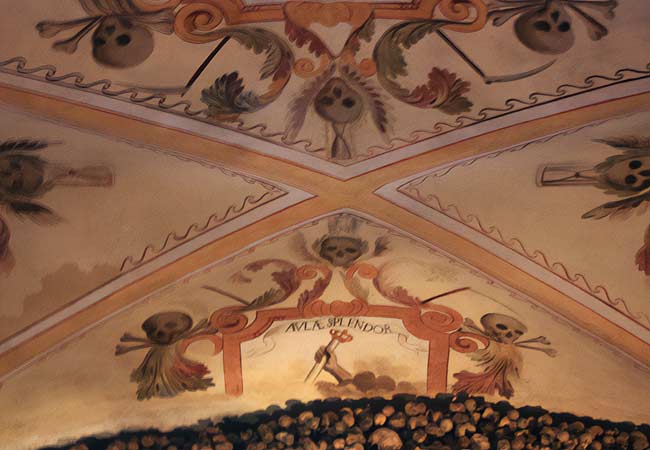
The Traveller's Poem
Hanging on one of the pillars is the ‘Traveller’s Poem’, written by António da Ascenção Teles in 1847. It reads:
" Where are you going in such a hurry, traveller? Pause...do not advance your travel. You have no greater concern, than business Than this one: that on which you focus your sight.
Recall how many have passed from this world, Reflect on your similar end. There is good reason to do so; If only all did the same.
Ponder, you so influenced by fate, Among the many concerns of the world, So little do you reflect on death.
If by chance you glance at this place, Stop ... for the sake of your journey, The longer you pause, the further on your journey you will be.
Outside of the chapel Capela dos Ossos
To counter the sense of death, and the macabre ambience of the chapel, the surrounding rooms contain ideas of birth and life.
On the wall opposite the chapel is the modern and simplistic tile painting by Siza Vieira, depicting the miracle of birth. Much more charming is the nativity scene, recreated as if it were in Evora. This delightful model, with over 120 characters and famous buildings of Evora, is the highlight of the Canha da Silva Nativity Collection that is located on the upper floor of the monastery.
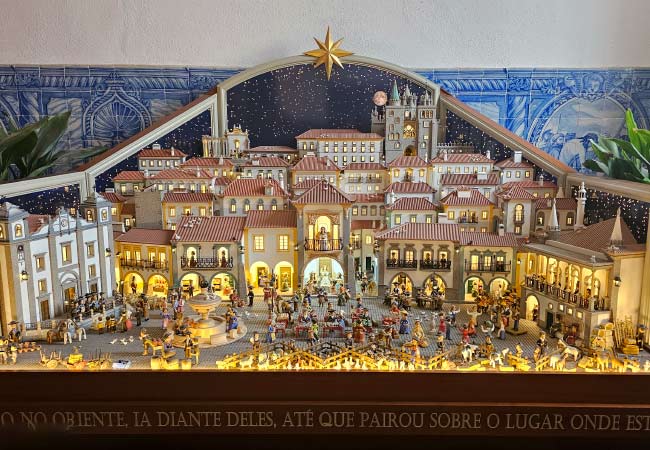
The cathedral altar prototype
The central feature in the room adjoining the Capela dos Ossos is the full-scale model of an altar proposed for the remodelling of the Se Cathedral. Interestingly, the final design of the altar used very few elements from this prototype and is completely different.
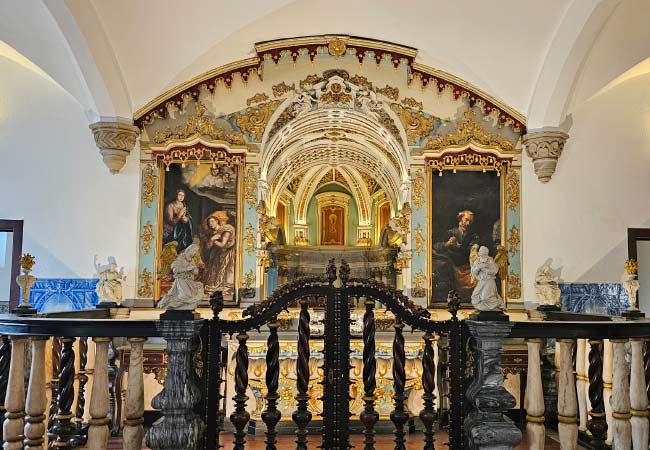
Canha da Silva Nativity collection
Exhibited in the museum above the Capela dos Ossos (and included in the entrance fee) is the private collection of nativity scenes obtained by Canha da Silva and his wife over a 35-year period. This delightful and unique collection includes nativity scenes from over 80 countries and displays 400 of the best sets from their total collection of 2,600 pieces.
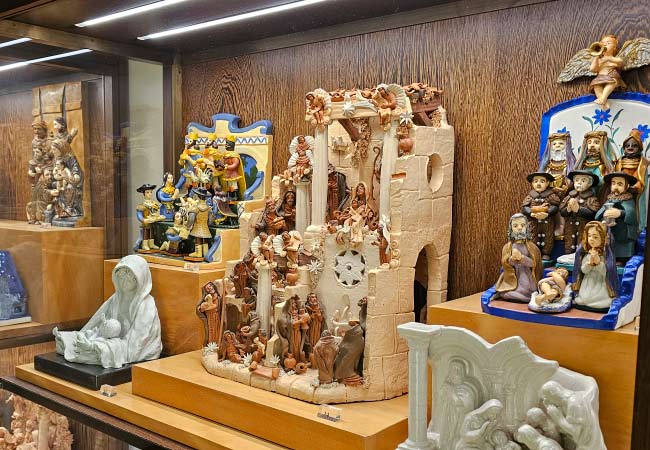
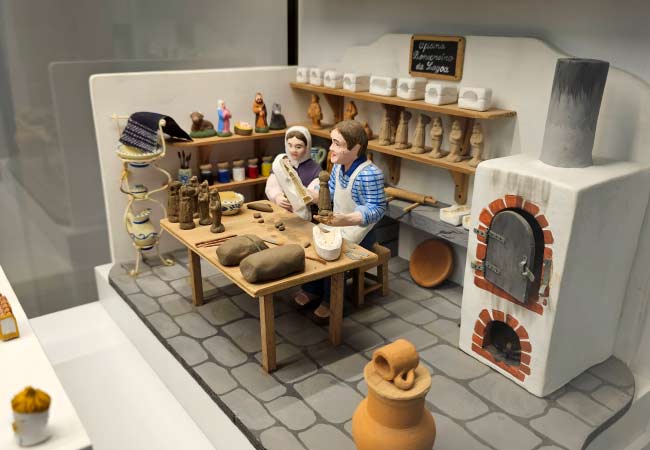
The Religious Art Museum
The former dormitory of the monastery above the Capela dos Ossos has been converted into a museum displaying sacred art and sculptures from the 16th and 18th centuries.
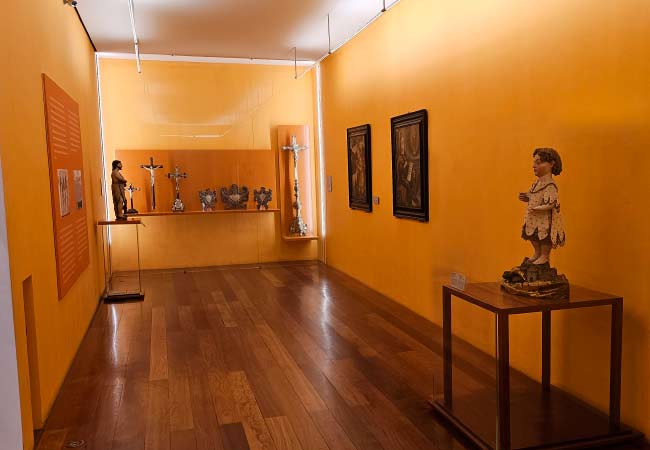
Igreja de São Francisco
Igreja de São Francisco The Igreja de São Francisco may be the less visited tourist sight compared to the Bone Chapel, but it is still an important religious monument known for its exquisite Gothic and Manueline architectural styles. Its construction began in 1470 and was completed in 1510, with master masons Martim Lourenço and Pero de Trilho overseeing the project.
The church's grandeur is evident in its soaring vaulted nave, adorned with symbols like the cross of the Order of Christ and emblems of King D. João II and King D. Manuel I, reflecting Portugal's maritime expansion era. The Convent of São Francisco, was established in the 13th century, and was the first Franciscan house in Portugal.
Over time, the church underwent significant remodeling, and during its golden period, it became the Royal Chapel of King Don Afonso V. However, subsequent years saw a decline in its fortunes, reflecting the lesser importance of Évora in the kingdom of Portugal.
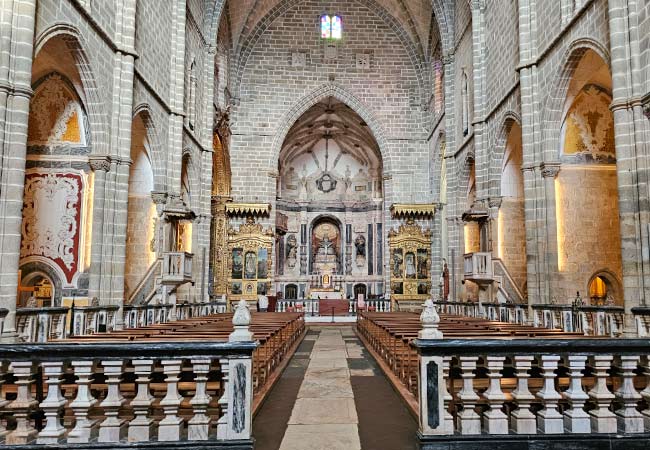
The church's architectural highlights include Gothic-Manueline features in its facades, portico, and nave, with ten side chapels housing ornate altarpieces from the 18th century. The main chapel features an 18th-century marble altarpiece, contrasting with the Manueline style elsewhere.
The Ordem Terceira chapel combines Baroque carvings with Franciscan-themed tiles and canvases, while the Chapel of São Joãozinho boasts a 16th-century marble sculpture of the Angel of the Annunciation. The chapter room was transformed into the Chapel of Senhor dos Passos, which houses the Tears of Saint Peter painting.
The Igreja de São Francisco was designated as a National Monument in 1910.



























